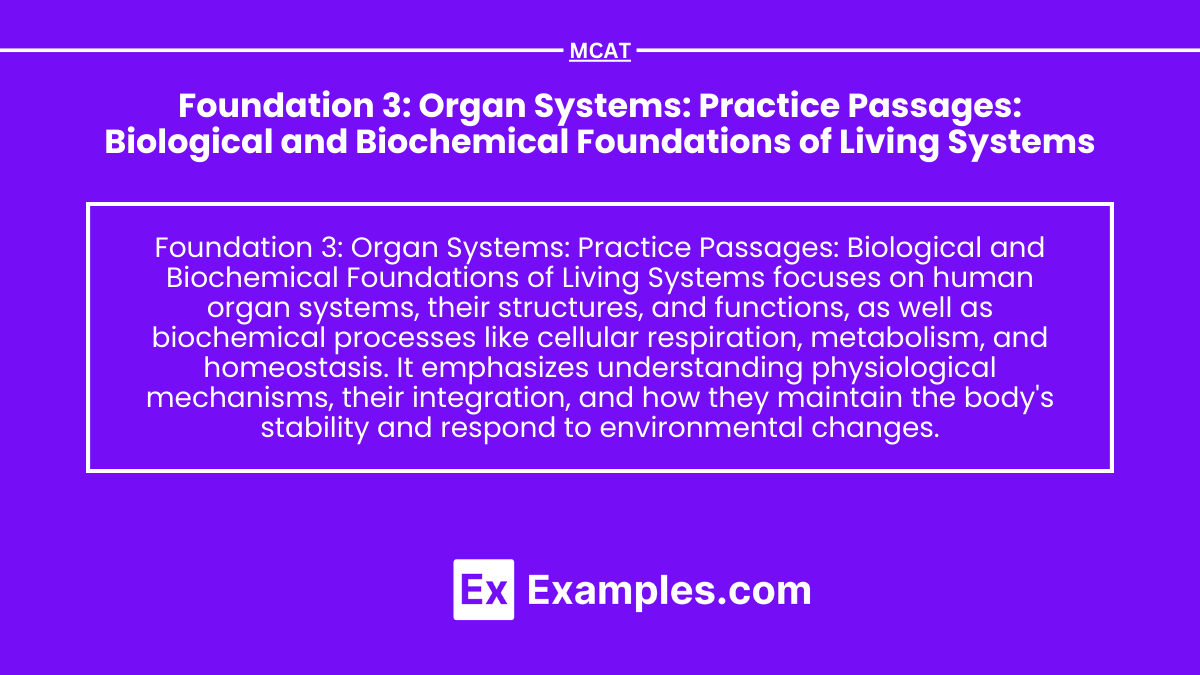Foundation 3: Organ Systems: Practice Passages: Biological and Biochemical Foundations of Living Systems

- Notes
The MCAT’s Foundation 3 section emphasizes understanding organ systems through the biological and biochemical lenses, testing knowledge of human physiology and cellular processes. Key areas include cellular structure, biochemical pathways, and the interaction of systems to maintain homeostasis. Practice passages often integrate clinical cases, requiring an understanding of how organ systems respond to physiological and pathological changes.
Learning Objectives
In studying “Foundation 3: Organ Systems: Biological and Biochemical Foundations of Living Systems” for the MCAT, you should learn to understand the structure and function of major organ systems, including the circulatory, respiratory, nervous, and digestive systems. Analyze how these systems maintain homeostasis, interact with one another, and respond to internal and external stimuli. Evaluate the physiological mechanisms involved in organ system functions, such as gas exchange, nutrient absorption, and neural communication. Additionally, practice applying these concepts to MCAT-style questions through passages that test your ability to integrate knowledge of biology, biochemistry, and physiology.
1. Cellular Structure and Function

- Understand how cells within different organ systems function, including eukaryotic cell components (nucleus, mitochondria, endoplasmic reticulum) and prokaryotic cells.
- Review cell signaling, membrane transport (passive and active transport), and how these processes relate to organ system functions like nervous system signal transmission or kidney filtration in the excretory system.
2. Organ Systems: Overview
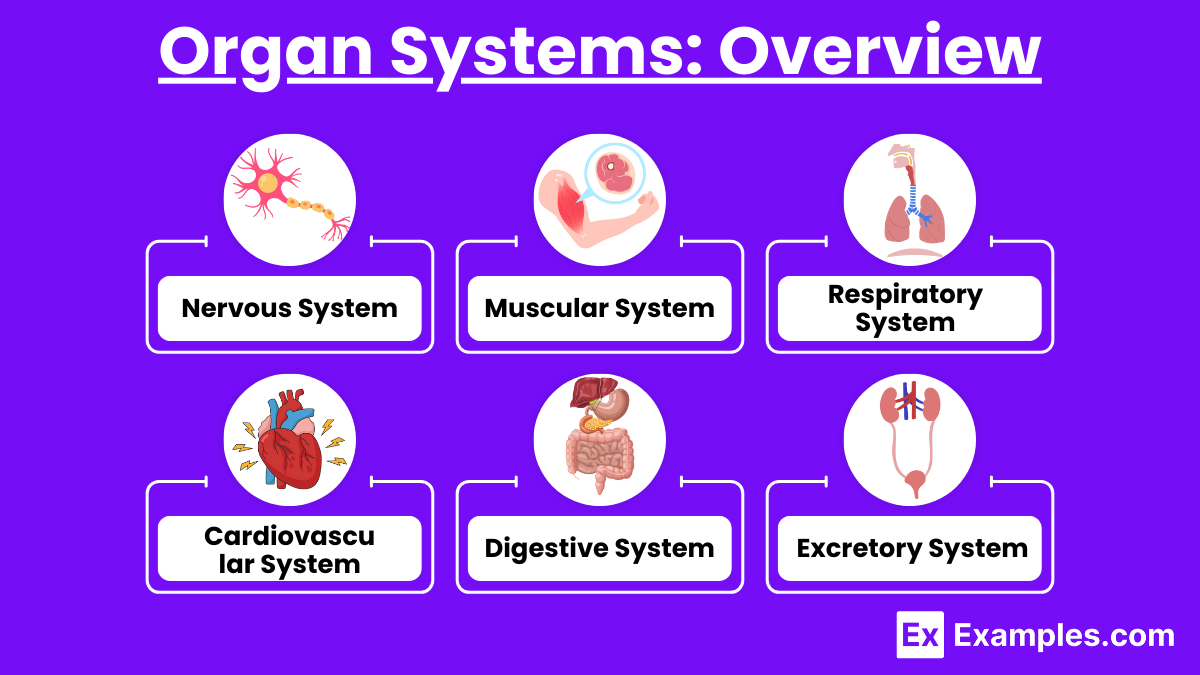
- Nervous System:
- Understand the organization of the central and peripheral nervous systems, the role of neurons and synaptic transmission, and reflex arcs.
- Study neurotransmitters and their roles, along with the mechanisms of sensory processing, motor functions, and autonomic nervous regulation.
- Muscular System:
- Focus on skeletal, smooth, and cardiac muscles, and their roles in body movement, digestion, and blood circulation.
- Review muscle contraction mechanisms, including the sliding filament theory and the role of calcium and ATP.
- Respiratory System:
- Understand gas exchange in alveoli, the role of hemoglobin in oxygen transport, and how breathing is regulated through homeostatic mechanisms.
- Cardiovascular System:
- Learn about heart anatomy, the cardiac cycle, and the electrical conduction system of the heart.
- Study the role of arteries, veins, and capillaries in blood transport and exchange, as well as the regulation of blood pressure and blood flow.
- Digestive System:
- Review enzyme activity in digestion, nutrient absorption in the intestines, and the roles of organs like the liver and pancreas.
- Excretory System:
- Focus on kidney function in osmoregulation, filtration, and waste removal through nephrons.
- Endocrine System:
- Study hormones, their receptors, and the feedback systems governing growth, metabolism, and homeostasis. Understand the major glands (pituitary, thyroid, adrenal) and their hormone functions.
- Immune System:
- Learn about innate and adaptive immunity, including the roles of leukocytes, antibodies, and the lymphatic system.
3. Biochemical Pathways
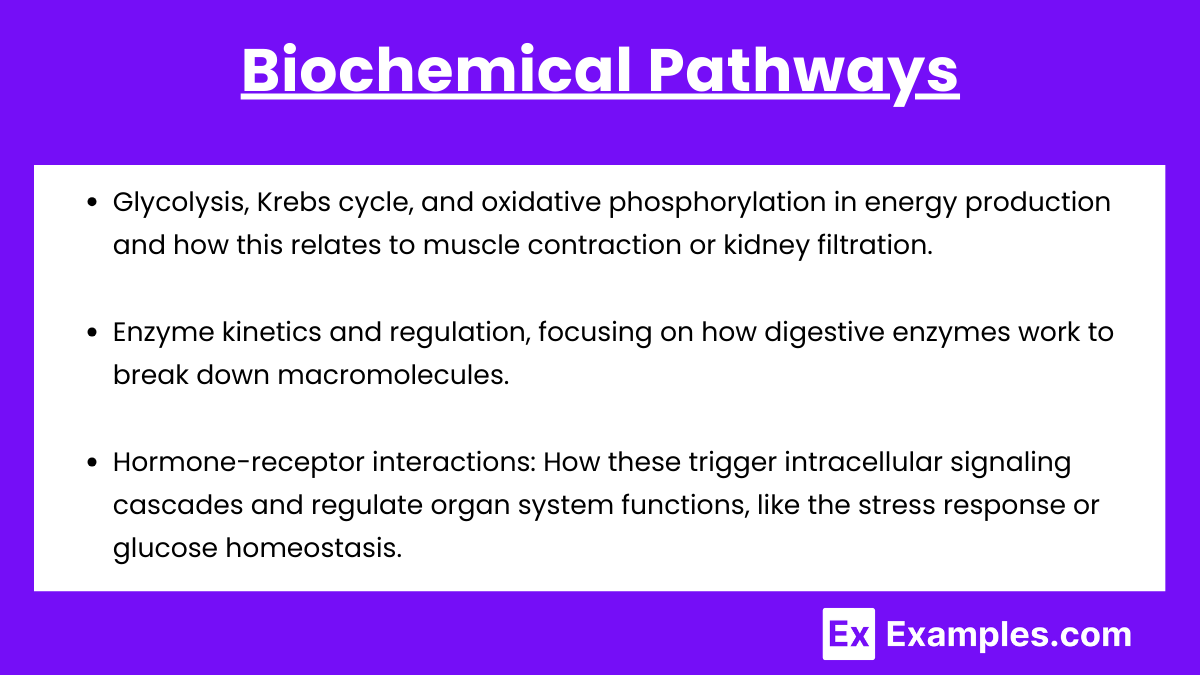
- Understand how biochemical pathways are integrated into organ system functions. For instance:
- Glycolysis, Krebs cycle, and oxidative phosphorylation in energy production and how this relates to muscle contraction or kidney filtration.
- Enzyme kinetics and regulation, focusing on how digestive enzymes work to break down macromolecules.
- Hormone-receptor interactions: How these trigger intracellular signaling cascades and regulate organ system functions, like the stress response or glucose homeostasis.
4. Disease States and Clinical Correlations
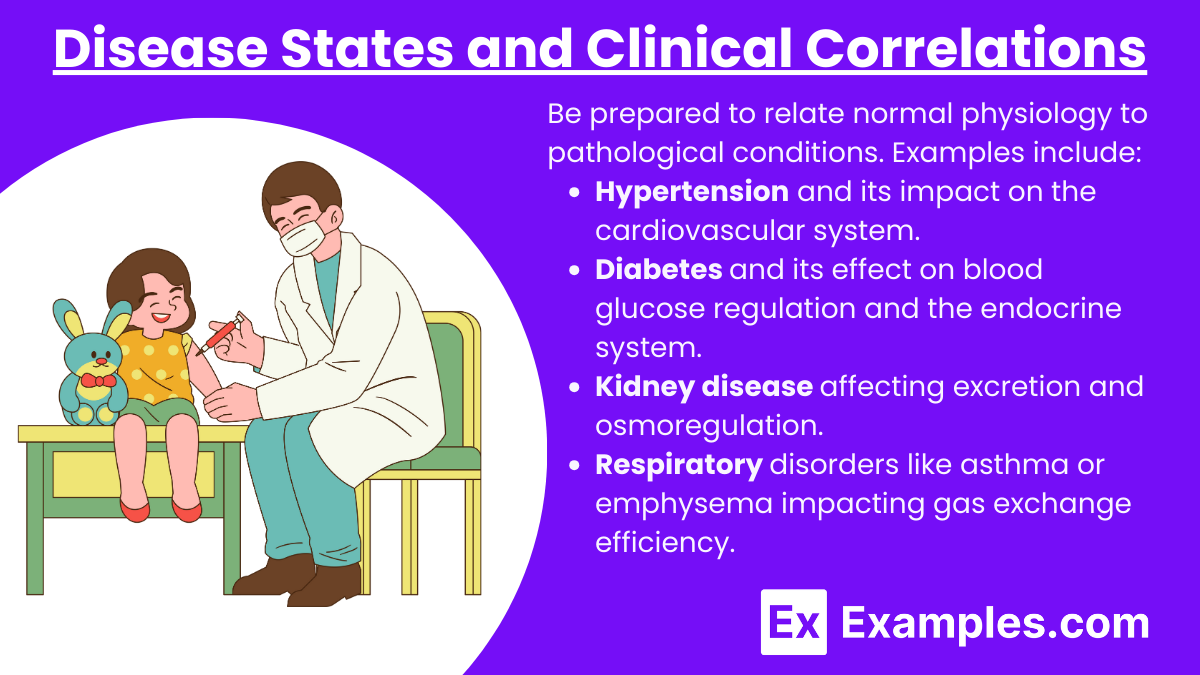
- Be prepared to relate normal physiology to pathological conditions. Examples include:
- Hypertension and its impact on the cardiovascular system.
- Diabetes and its effect on blood glucose regulation and the endocrine system.
- Kidney disease affecting excretion and osmoregulation.
- Respiratory disorders like asthma or emphysema impacting gas exchange efficiency.
Examples
Example 1: Cardiovascular and Respiratory Interaction
A passage describes the effects of strenuous exercise on heart rate and oxygen demand, illustrating how the cardiovascular and respiratory systems work together to maintain oxygen homeostasis and support increased metabolic activity.
Example 2: Digestive Enzyme Deficiency
The scenario details a patient with lactose intolerance, focusing on enzyme function and nutrient absorption, highlighting the biochemical and physiological aspects of the digestive system and the consequences of enzyme deficiencies on nutrient metabolism.
Example 3: Endocrine Response to Stress
This passage explores the release of cortisol during stress, examining the endocrine system’s role in metabolism and immune response regulation, demonstrating how hormones influence physiological processes across multiple organ systems.
Example 4: Renal Function and Filtration
A case study follows a patient with kidney disease, focusing on the nephron’s role in filtration and osmoregulation, showing how the excretory system maintains fluid balance and eliminates waste from the body.
Example 5: Immune Response to Pathogens
The passage presents an infection scenario, examining how the immune system’s adaptive and innate responses defend against pathogens, emphasizing leukocyte function, antigen recognition, and the body’s biochemical defenses in disease resistance.
Practice Questions
Question 1:
Which of the following best describes the role of hemoglobin in the respiratory system?
A) Enzyme that breaks down carbon dioxide
B) Hormone that regulates breathing rate
C) Protein that transports oxygen in the blood
D) Neurotransmitter involved in gas exchange
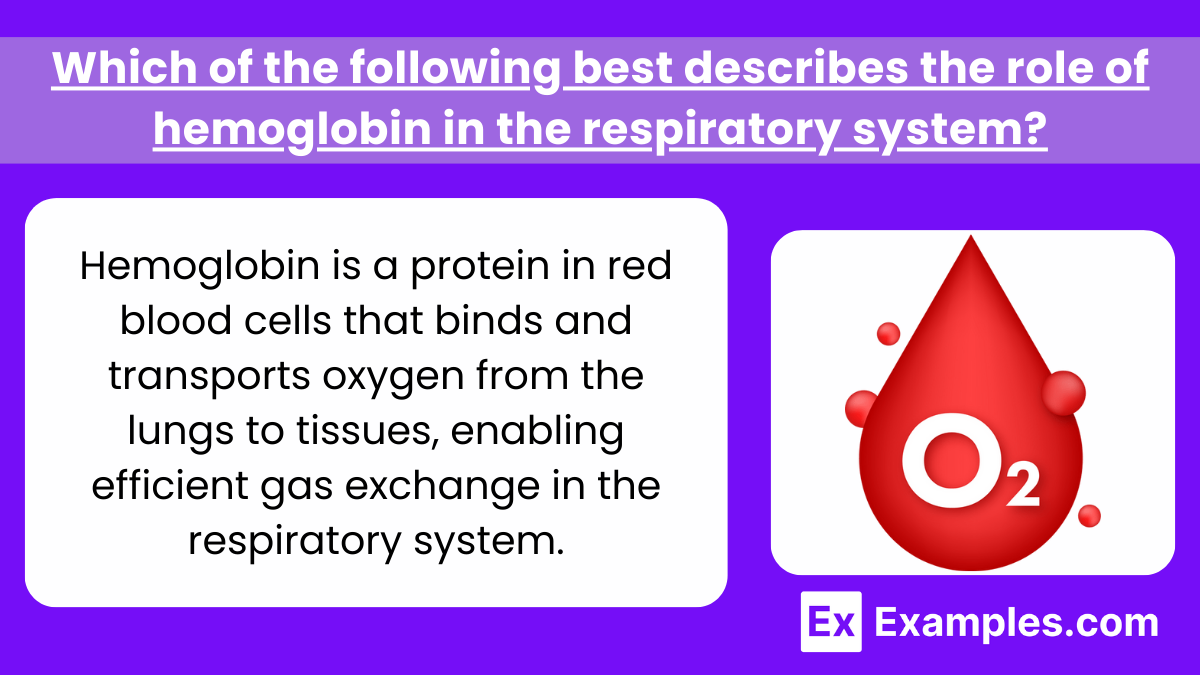
Answer: C) Protein that transports oxygen in the blood
Explanation: Hemoglobin is a protein in red blood cells that binds and transports oxygen from the lungs to tissues, enabling efficient gas exchange in the respiratory system.
Question 2:
Which organ system is primarily responsible for regulating electrolyte balance and blood pressure?
A) Cardiovascular
B) Respiratory
C) Excretory
D) Digestive
Answer: C) Excretory
Explanation: The excretory system, particularly the kidneys, maintains electrolyte balance and blood pressure by filtering blood and regulating sodium, potassium, and water levels.
Question 3:
What is the primary function of insulin within the endocrine system?
A) Increase blood glucose levels
B) Facilitate glucose uptake into cells
C) Break down glycogen into glucose
D) Release calcium from bones
Answer: B) Facilitate glucose uptake into cells
Explanation: Insulin, a hormone produced by the pancreas, facilitates glucose uptake into cells, helping to decrease blood glucose levels and regulate energy metabolism.
The MCAT’s Foundation 3 section emphasizes understanding organ systems through the biological and biochemical lenses, testing knowledge of human physiology and cellular processes. Key areas include cellular structure, biochemical pathways, and the interaction of systems to maintain homeostasis. Practice passages often integrate clinical cases, requiring an understanding of how organ systems respond to physiological and pathological changes.
Learning Objectives
In studying "Foundation 3: Organ Systems: Biological and Biochemical Foundations of Living Systems" for the MCAT, you should learn to understand the structure and function of major organ systems, including the circulatory, respiratory, nervous, and digestive systems. Analyze how these systems maintain homeostasis, interact with one another, and respond to internal and external stimuli. Evaluate the physiological mechanisms involved in organ system functions, such as gas exchange, nutrient absorption, and neural communication. Additionally, practice applying these concepts to MCAT-style questions through passages that test your ability to integrate knowledge of biology, biochemistry, and physiology.
1. Cellular Structure and Function
Understand how cells within different organ systems function, including eukaryotic cell components (nucleus, mitochondria, endoplasmic reticulum) and prokaryotic cells.
Review cell signaling, membrane transport (passive and active transport), and how these processes relate to organ system functions like nervous system signal transmission or kidney filtration in the excretory system.
2. Organ Systems: Overview
Nervous System:
Understand the organization of the central and peripheral nervous systems, the role of neurons and synaptic transmission, and reflex arcs.
Study neurotransmitters and their roles, along with the mechanisms of sensory processing, motor functions, and autonomic nervous regulation.
Muscular System:
Focus on skeletal, smooth, and cardiac muscles, and their roles in body movement, digestion, and blood circulation.
Review muscle contraction mechanisms, including the sliding filament theory and the role of calcium and ATP.
Respiratory System:
Understand gas exchange in alveoli, the role of hemoglobin in oxygen transport, and how breathing is regulated through homeostatic mechanisms.
Cardiovascular System:
Learn about heart anatomy, the cardiac cycle, and the electrical conduction system of the heart.
Study the role of arteries, veins, and capillaries in blood transport and exchange, as well as the regulation of blood pressure and blood flow.
Digestive System:
Review enzyme activity in digestion, nutrient absorption in the intestines, and the roles of organs like the liver and pancreas.
Excretory System:
Focus on kidney function in osmoregulation, filtration, and waste removal through nephrons.
Endocrine System:
Study hormones, their receptors, and the feedback systems governing growth, metabolism, and homeostasis. Understand the major glands (pituitary, thyroid, adrenal) and their hormone functions.
Immune System:
Learn about innate and adaptive immunity, including the roles of leukocytes, antibodies, and the lymphatic system.
3. Biochemical Pathways
Understand how biochemical pathways are integrated into organ system functions. For instance:
Glycolysis, Krebs cycle, and oxidative phosphorylation in energy production and how this relates to muscle contraction or kidney filtration.
Enzyme kinetics and regulation, focusing on how digestive enzymes work to break down macromolecules.
Hormone-receptor interactions: How these trigger intracellular signaling cascades and regulate organ system functions, like the stress response or glucose homeostasis.
4. Disease States and Clinical Correlations
Be prepared to relate normal physiology to pathological conditions. Examples include:
Hypertension and its impact on the cardiovascular system.
Diabetes and its effect on blood glucose regulation and the endocrine system.
Kidney disease affecting excretion and osmoregulation.
Respiratory disorders like asthma or emphysema impacting gas exchange efficiency.
Examples
Example 1: Cardiovascular and Respiratory Interaction
A passage describes the effects of strenuous exercise on heart rate and oxygen demand, illustrating how the cardiovascular and respiratory systems work together to maintain oxygen homeostasis and support increased metabolic activity.
Example 2: Digestive Enzyme Deficiency
The scenario details a patient with lactose intolerance, focusing on enzyme function and nutrient absorption, highlighting the biochemical and physiological aspects of the digestive system and the consequences of enzyme deficiencies on nutrient metabolism.
Example 3: Endocrine Response to Stress
This passage explores the release of cortisol during stress, examining the endocrine system’s role in metabolism and immune response regulation, demonstrating how hormones influence physiological processes across multiple organ systems.
Example 4: Renal Function and Filtration
A case study follows a patient with kidney disease, focusing on the nephron's role in filtration and osmoregulation, showing how the excretory system maintains fluid balance and eliminates waste from the body.
Example 5: Immune Response to Pathogens
The passage presents an infection scenario, examining how the immune system’s adaptive and innate responses defend against pathogens, emphasizing leukocyte function, antigen recognition, and the body's biochemical defenses in disease resistance.
Practice Questions
Question 1:
Which of the following best describes the role of hemoglobin in the respiratory system?
A) Enzyme that breaks down carbon dioxide
B) Hormone that regulates breathing rate
C) Protein that transports oxygen in the blood
D) Neurotransmitter involved in gas exchange
Answer: C) Protein that transports oxygen in the blood
Explanation: Hemoglobin is a protein in red blood cells that binds and transports oxygen from the lungs to tissues, enabling efficient gas exchange in the respiratory system.
Question 2:
Which organ system is primarily responsible for regulating electrolyte balance and blood pressure?
A) Cardiovascular
B) Respiratory
C) Excretory
D) Digestive
Answer: C) Excretory
Explanation: The excretory system, particularly the kidneys, maintains electrolyte balance and blood pressure by filtering blood and regulating sodium, potassium, and water levels.
Question 3:
What is the primary function of insulin within the endocrine system?
A) Increase blood glucose levels
B) Facilitate glucose uptake into cells
C) Break down glycogen into glucose
D) Release calcium from bones
Answer: B) Facilitate glucose uptake into cells
Explanation: Insulin, a hormone produced by the pancreas, facilitates glucose uptake into cells, helping to decrease blood glucose levels and regulate energy metabolism.

